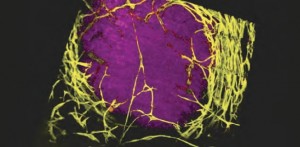About two months ago, I started a new job, providing science information for the Cancer Research UK Create the Change Campaign, which is dedicated to raising money for the Francis Crick Institute. It’s been a real eye-opener; ironically, although I’ve worked in labs dedicated to medical research for much of my adult life, I feel as though I’m only now appreciating the importance and magnitude of the task to turn cancer into a curable, or at least manageable, disease that we no longer fear. The staff at Cancer Research UK headquarters are focussed on funding, managing and communicating research which may one day make this dream a reality, but they are also exposed to the heart-wrenching tragedies wrought by cancer in a way that scientists, sheltered in their labs, rarely encounter in the raw.
Day to day lab life is far removed from lofty ideals such as the desire to improve human health. One might think about it occasionally, but in my experience, scientists are positively motivated by things such as curiosity, having fun, keeping their brains busy, and doing what they like whilst getting paid for it. Later on, the happy stuff can get a bit overwhelmed by anxiety about grant renewals, rapacious competitors, malevolent reviewers, stalled projects and the like, but again, nobody really worries about their lack of progress in saving humankind.This is as it should be. Wanting to help people is obviously laudable, but is not what makes a great scientist. The discoveries that advance our knowledge are made by clever, driven people; their insatiable curiosity and single-mindedness can appear selfish and odd to those around them, but in the end, they are the pioneers and dreamers who move medical knowledge forwards. There would be no path from bench to bedside without such adventurers, and we still need them: despite all we have learnt in the sixty years since the structure of DNA was elucidated, there’s an awful lot out there that we have yet to find.
The most simultaneously interesting and depressing thing I’ve learnt as part of my new job is that cancer medicine has reached something of an impasse. Despite a huge and costly worldwide research effort that has seen a revolution in what we know about the basic biology of cancer, the age-adjusted cancer mortality rate has barely changed since the 1950s. Whilst we should never forget that together, prevention, screening and successes with the more tractable cancer types have saved millions of lives, the prognosis for someone with metastatic cancer is almost as grim today as it was 50 years ago. We are not yet winning the war against cancer; when the Nobel laureate and cancer geneticist Harold Varmus became director of the US National Cancer Institute in 2010, he told an audience: “We have not succeeded in controlling cancer as a human disease.”
What we’ve learnt over the last half century is immense. We know that cancer is caused by genetic changes, and in many cases we know what these changes are. We also know a lot about what is going on in individual cancer cells. We have developed drugs which pinpoint specific mutations in specific cancers, even in specific cells within those cancers. However, whilst undeniably necessary, and reasonably successful, our intense focus on the minutiae of the disease has led to a certain loss of perspective; that cancer is a disease of the organism, the system. The environment in which cancer cells find themselves will often determine whether tiny pre-malignancies remain as small aberrations kept well under control by the body, or grow into life-threatening tumours. So, whilst research into the basic biology of cancer remains important, and new therapies are giving us great cause for hope, the basic research community is also rebooting itself with a new priority: to widen its focus to study the disease at a systems level. And to pursue this new approach, biologists have come full circle, and rediscovered what I discuss in Chapter 1 of Blue Skies and Bench Space: the importance of the physical sciences to biology.

Intravital microscopy of melanoma (purple) and associated blood vessels (yellow).
Photograph courtesy of Erik Sahai, CRUK London Research Institute
1. Information and complexity: Physical scientists are turning their minds to making sense of the enormous amounts of data that biologists are now generating. Mathematicians, statisticians and theoretical physicists are inventing new strategies for mining the cancer data mountain, and are also adapting the methods they already have to understand and predict how complex biological systems work.
2. Microenvironment: The surroundings of cells are crucial to their growth, both normal and cancerous. Microengineering is being used to design 2-D and 3-D matrices which can mimic the microenvironment so that it can be studied outside the body.
3. Cancer cell and tissue mechanics: Forces generated by cells, and the “stiffness” of cells and their extracellular jackets (the extracellular matrix) affect growth, survival, cell fate, and movement. Physicists and engineers are developing methods of precisely quantitating these forces, so we can better understand and combat the spread of cancer cells.
4. Transport: The movement of cancer cells, nutrients, growth factors, waste products, drugs, and fluids affect cell survival, tissue mechanics and therapy. Physicists can model these movements, to study, for example, the importance of fluid flow in the vascularisation of tumours, the immune system’s response to tumours, and how to achieve more effective targeting of anti-cancer therapies.
5. Devices and new diagnostic principles: Applied physics and engineering are key in developing new technologies, especially those in which the physical properties of tissues are exploited for cancer diagnosis or treatment.
The need for a new strategy in basic research into cancer is what is driving Cancer Research UK’s involvement in the Francis Crick Institute. The Crick is being set up to enable easy collaboration between scientists from many different disciplines, and there is every likelihood of its succeeding, as all the ingredients of a great scientific environment will be in place: good people; good facilities; good location, and good funding. I’m actually quite proud to be helping to raise money for it.
Although inspired by the coincidence that both Blue Skies and Bench Space and my current occupation deal with how step changes in cancer research are driven, there’s another, more personal reason that has dictated the subject of this blog. I’ve been incredibly lucky in the cancer stakes so far – it’s unusual to have reached my age without losing someone to the disease. However, all that changed two weeks ago, when Michael Neuberger, a truly great scientist, and one of the best, brightest and loveliest people I’ve ever met, died of multiple myeloma at the age of 59. Despite being in possession of a brain that worked so fast and so efficiently that it was frequently several paragraphs ahead of his mouth, he was totally unintimidating, and the year I was lucky enough to spend in his lab was an unalloyed delight. He woke up my mind in a way that had never happened before, and for which I’ll be forever grateful. Dear Michael, we’re all going to miss you very much.Further reading:
“Addressing the Growing International Challenge of Cancer: A Multinational Perspective” Harold Varmus and Harpal S. Kumar
Physical scientists take on cancer – a Nature supplement. Behind their paywall, unfortunately, but worth reading if you have access to a subscription.



Discussion
No comments yet.